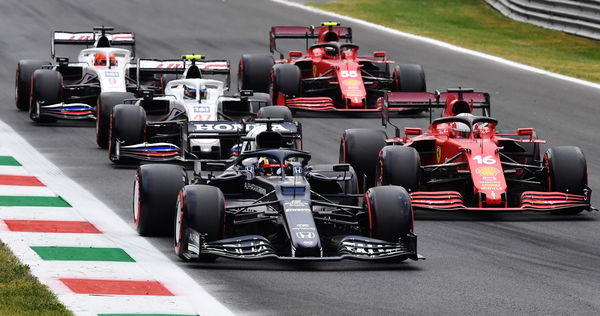
Reuters
Formula One F1 – Dutch Grand Prix – Circuit Zandvoort, Zandvoort, Netherlands – September 4, 2021 Red Bull’s Max Verstappen after qualifying in pole position Pool via REUTERS/Piroschka Van De Wouw

Reuters
Formula One F1 – Dutch Grand Prix – Circuit Zandvoort, Zandvoort, Netherlands – September 4, 2021 Red Bull’s Max Verstappen after qualifying in pole position Pool via REUTERS/Piroschka Van De Wouw
The braking system in F1 cars draws some similarities with their on-road counterparts, but a hand brake isn’t one of them. Similar to a road car, however, the brakes on an F1 car work on all four wheels.
Watch What’s Trending Now!
Although the addition of handbrakes would ensure another level of safety, there is no place in an F1 monocoque for the device. Additionally, it wouldn’t make sense to install a hand brake for the drivers. An F1 car has a complex braking system that is composed of two circuits of brakes. This means that in case of a braking failure, the second circuit takes over.
ADVERTISEMENT
F1 braking system explained
Braking is an important part of an F1 race. It’s crucial in the cornering phase of an F1 car. If the car does not brake in the correct position and the pressure on the pedal is incorrect, it affects the remaining phases of making the corner – from hitting the apex and taking the right line to making a clean exit. This also impacts a driver’s lap time.
Technical regulations require each car to have a twin-circuit hydraulic braking system with two separate tanks for front and rear wheels. This guarantees that, even with a complete circuit failure, the braking must still be available through the second circuit. Drivers can control the amount of braking power that goes into the front and rear circuits in the cockpit.
Top Stories
“Have Some Shame”- Fans Tear Apart F1 Pundits’ Shocking 2025 Driver Ranking

Who Is Lando Norris’ Girlfriend? Everything You Need to Know About Margarida Corceiro

Why Does the Internet Dislike Charles Leclerc’s GF, Alexandra Saint Mleux?

Carlos Sainz Family: Everything We Know About His Parents and Siblings

Who Are Lando Norris’s Parents? Meet Adam Norris and Cisca Wauman

ADVERTISEMENT
ADVERTISEMENT
This allows a to stabilize or take into consideration the fall of the fuel load. Under normal operation, about 60% of braking power goes to the front wheels. Because of transferring the load into the deceleration, they take most of the retardation work.
When the driver steps on the brake pedal, it compresses two master brake cylinders, one for the front wheels and one for the rear wheels, generating hydraulic pressure. The fluid pressure is sent directly to the front brake calipers.

Reuters
Formula One F1 – Italian Grand Prix – Autodromo Nazionale Monza, Monza, Italy – September 10, 2021 AlphaTauri’s Yuki Tsunoda with Ferrari’s Charles Leclerc and drivers during qualifying REUTERS/Jennifer Lorenzini
At the rear, there are three separate sources: friction from the brakes, resistance from the spinning engine, called ‘engine braking’ and electrical braking that takes energy generated by the hybrid electric motor.
ADVERTISEMENT
Thus, the requirement for a handbrake is unnecessary. F1 cars have their own unique braking system, helping the drivers maintain speeds while also ensuring efficiency and security.
Watch this story: Lewis Hamilton’s Biggest F1 Crashes
ADVERTISEMENT
ADVERTISEMENT
ADVERTISEMENT
ADVERTISEMENT

